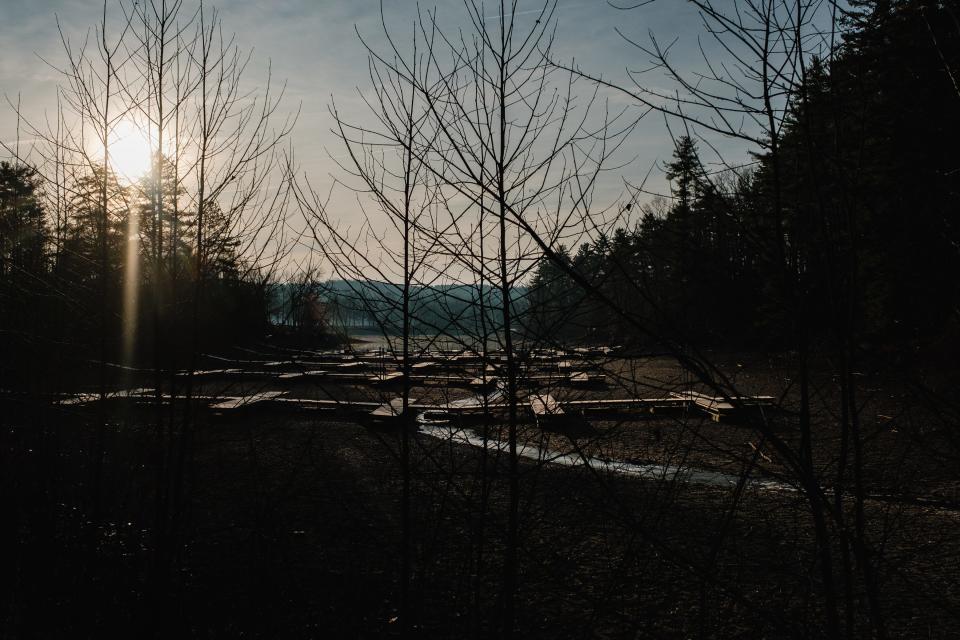For most of this winter, El Niño has meant warmer than normal winter temperatures for Ohio
NEW PHILADELPHIA — How does the saying about weather in Ohio go — If you don't like it, wait five minutes? Well, for ice fishermen, local businesses and other winter-loving outdoor enthusiasts in the region, that just may well feel like an eternity right now.
Although the National Weather Service forecast for the the county calls for wintry weather this weekend and overnight lows dipping into the single digits early next week, overall, winter in the Northern Hemisphere has been abnormally warm this year. There’s a reason for that, according to the National Oceanic Atmospheric Organization: El Niño. You’ve heard the term, but what is it exactly?

An El Niño develops when water surface temperatures are warmer than average in the eastern equatorial Pacific Ocean for an extended time, according to a report in the National Integrated Drought Information System.
El Niño conditions can affect North American weather patterns, especially in the winter and early spring.
While each El Niño is different, the report states some general patterns are predictable. For instance, the polar jet stream is typically farther north than usual, while the Pacific jet stream tends to remain across the southern U.S. This pattern brings increased chances of above-normal temperatures to the Great Lakes region.
Cold weather will still occur — including next week — but cold air outbreaks tend to be less frequent. According to the National Weather Service forecast for the area, snow is possible Saturday and early next week. After a high near 48 degrees Friday, temperatures are expected to drop, with a low around 7 expected Tuesday night.
El Niño also increases the chances of dry conditions, especially in the southern portion of the Great Lakes basin, directly impacting weather patterns in Ohio.
More: Ohio weather giving ski resorts the cold shoulder. Just 2 of 5 are open
While mild winters with significantly lower snowfall amounts can help sections of the economy such as homebuilding and home sales, there are other economic impacts more readily felt, such as salt sales, snow removal and towing.
Area business owners weigh in
Local tow operator Alex Rosenberry of Rosenberry's Towing, which has been in operation since 1967, purchased the business from his uncles in 2020.
"It's very common for the general public to make the comment of us wanting snowfall. The truth is we generally stay busy year-round, while summer months are our busiest. Snowfall and winter weather events can definitely spike incoming call volume, however with winter weather — especially icy around our region — comes a lot higher risk of damaging equipment and creates extended (response times) for customers," he said.
"We have seen a typical slowdown across the past few weeks during the holidays, which is pretty normal from past years' data," Rosenberry said. "Should we get some snowfall later into the season we are definitely prepared with salt, snow removal equipment, and a full staff ready to go 24/7 but it won't break our heart if we have another mild winter to keep our risk exposure low."
In Harrison County, Tappan Lakeside Resort co-owner Kodi Brock said they don't have enough history in operations after two years of operations to indicate differences between winters just yet. Although it is the off-season for the resort, which features rentals in four different sizes overlooking the lake, Brock anecdotally recalls last winter being busier because of the snow and deep freeze.
ODNR offers tips for ice fishing
Up until now, the unseasonably warm weather has meant no visible development of lake or pond ice, making ice fishing impossible.
Matt Thomas, chief of conservation for Muskingum Watershed Conservancy District, said the organization does not track ice coverage or have measurable imagery reflecting relative coverage. He also said he is unaware of environmental impacts. During the winter seasons where thick ice on the lake is present, "we will see a number of people ice fishing, but to my knowledge, not so much that it will impact the local economy during years of thin or little ice."
Should area lakes freeze over, the Ohio Department of Natural Resources offers these tips for ice fishing:

● No ice is safe ice. ● Have a valid Ohio fishing license.● Know the size and daily limits for the fish that you hope to catch.● Learn the ice fishing regulations for where you are fishing. ● Make a checklist of things you will need to have fun and be safe. ● Consider leaving a float plan with someone who knows that you will be out on the ice, indicating where you plan to fish, where you plan to park your vehicle, and when you plan to return home. For boaters, this is common practice and for ice anglers, it’s not a bad idea either. ● Once the freeze is on, check the most recent ice fishing reports, or make a quick stop at the local bait shop to find out what’s biting and where. As always, be safe when you head out on the ice and for more information, call 1-800-WILDLIFE or contact your local wildlife district office.
T-R staff photographer Andrew Dolph can be reached by phone at 330-289-6072, or by email at adolph3@gannett.com
This article originally appeared on The Times-Reporter: El Niño has meant a warm winter so far, but cold weather is coming

